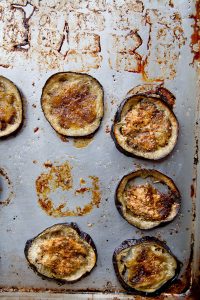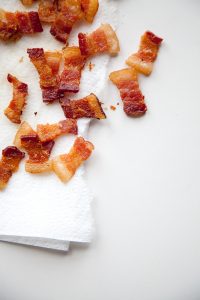You know what is even better than pizza? Having cold pizza for breakfast. My friend recently Iron Stef recently tweeted about putting a fried egg on day old pizza for breakfast, which sounded awesome. And putting an egg on a pizza while you bake it is totally an option too. Of course, in order to have any sort of you have to actually either buy or make pizza the night before in order to have pizza for breakfast, so that is the first important step.
This month’s Bon Appetit cover story features Jim Lahey’s recipe for slow fermentation pizza dough. As you may recall, Lahey is the guy who came up with the method for one of my favorite breads: Dutch Oven No-Knead Bread which is insanely delicious, easy to make, and is always an impressive crowd pleaser when it’s your turn to bring bread for a dinner party. The only thing you need to do is remember to get it started the night before. The same goes for his recipe for pizza dough – easy to do, but it just takes a while.
The basic theory is that you use a very small amount of yeast, and then you allow the dough to rise very slowly over a long period of time. Rather than developing the gluten with endless kneading after a fast rise, the character and flavor come from the slow fermentation. The slow fermentation comes as a result of using a tiny amount of yeast. Lahey’s recipe calls for 7.5 cups of flour and 1/2 teaspoon of yeast (enough dough for six small pies). By comparison, my quick pizza dough recipe which has been my go to for the last year or so takes only 1.5 cups of flour and 3/4 teaspoon of yeast (for one pie). Clearly I could save millions of dollars in yeast costs each year by doing the slow fermentation method. All right maybe not, seeing as I’ve only spent about $20 in yeast of the the last two years.
In any case, the results of the slow fermentation pizza dough are pretty impressive. The dough is crispy on the outside, but has the nice chewy inside to it as well. The long fermentation gives is a deep, rich flavor and unlike the quick pizza dough method, it is full of beautiful bubbles that puff up and char during the baking process. The dough is so flavorful that you can go even lighter on the toppings that you normally do on home made pizza. Believe me, you won’t be throwing out the crusts from these pizzas. I made two pizzas for dinner last night. I brushed each with olive oil, then topped one with roasted eggplant and goat cheese, and the other with shaved brussel sprouts, bacon lardons, and fontina. I sprinkled each pizza with sea salt, ground black pepper, and red pepper flakes. The combinations are endless.
One other wrinkle for this recipe is the baking method. Like most other pizza recipes, it calls for heating the oven (with a pizza stone) as hot as you can make it (550F preferred) for about an hour prior to baking (so essentially as long as the dough rest period). However, instead of simply baking the pizza on the stone, right before you put the pizza in you switch on the broiler. Note: this wouldn’t work in one of those ovens with the broiler in a separate drawer at the bottom. The residual heat from the pizza stone cooks the bottom of the pizza while the broiler cooks the top, giving you that lovely charred-in-spots blistered type of pizza you get from restaurants. You have to watch it very carefully so as not to burn the top. You’ll probably also have to rotate your pie about half way through unless you have a perfectly evenly heated oven.
One other note about this particular recipe: as I mentioned, it makes enough dough for six small pies. Obviously Dr. Fiance and I are not going to be eating six pies at one sitting. However, rather than cut the recipe down, I simply portioned out all six pieces, and then froze four of them, individually wrapped. In theory I’ll be able to let them defrost on the counter for a few hours before baking – I’ll let you know how that goes.
You can find the complete recipe for Jim Lahey’s No-Knead Pizza Dough at BonAppetit.com






5 Comments
Kimberly
March 5, 2012 at 1:27 pmMy mouth is watering! Both of those pizzas look amazing, and I really want to try this dough method … thanks for sharing!
Nam (required)
July 30, 2012 at 6:45 amthat last comment was from march 2012, now it is august 2012 and still no update. lahey specifies that the dough would last three days in the refrigerator and should not be frozen, so i’m probably not the only one who is interested in if and how the dough survived freezing. good idea to brush with olive oil, i’ll try that next time.
ShootToCook
July 30, 2012 at 11:57 amSo, freezing wasn’t the worst thing in the world but it wasn’t the best. The flavor was still great, but after being frozen the dough wasn’t as light and fluffy as it was before it was frozen. For the best results I would say that you shouldn’t freeze it. That said, making a pizza with this dough from the freezer is way tastier than pulling a pre-made pizza out of the freezer for a quick weeknight dinner.
Url.Org
February 28, 2013 at 1:15 pmLike many people, I like to get a prepared carry out pizza occasionally.
If you don’t, then you will have to bake each loaf separately.
Once the consistency is there, I knead for about a minute.
Andrej
March 15, 2017 at 12:36 pmSo, I should put the pizza stone right below the broiler, so it can heat it up fast?